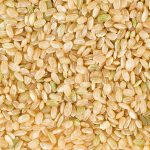Citreoviridin (CIT) is a highly toxic mycotoxin produced by the mould Penicillium citreoviridin (PCV) [ Penicillium citreonigrum]. The mould itself is a very common contaminant of a number of agricultural products. Its mode of action is to inhibit cell proliferation and it appears to damage a number of tissues and organs. The liver, kidney, heart and central nervous system (CNS) are all particularly vulnerable to this toxin (Bai et al., 2015)
The mycotoxin has also been extracted from a number of Pencillium moulds including P. charlesii (Cole et al., 1981). CIT has also been isolated from uranium mines and miners’ throats (Sram et al., 1993a, b).
The type of foodstuffs which have been contaminated are primarily rice and corn especially in Asia and South America respectively (Roas et al., 2010; Alemida et al., 2012). Nuts, especially pecan nuts have also been contaminated (Cole et al., 1981).
It has an unusual structure that consists of a lactone ring conjugated to a furan ring, and has a molecular weight of 402.5.
The acute toxicity, cardiotoxicity, and neurotoxicity of CIT have been studied since the 1970s. It has been found that CIT causes vomiting, convulsions, ascending paralysis, respiratory arrest, neurological symptoms, and depressed sensory responses in animals (Ueno, 1972; Ueno and Ueno, 1972; Datta and Ghosh, 1981). In mice, oral and intraperitoneal LD50s of CIT are 20 mg/kg and 7.5 mg/kg, respectively (Ueno and Ueno, 1972).
The mycotoxin affects the enzymes acetylcholinesterase and ATPase which are specifically located in the synaptosomes and microsomes of the brain (Datta & Ghosh, 1981a & b).
Reference
, , , , , , , . 2012. Co‐occurrence of aflatoxins B(1), B(2), G(1) and G(2), ochratoxin A, zearalenone, deoxynivalenol, and citreoviridin in rice in Brazil. Food Addit Contam Part A Chem Anal Control Expo Risk Assess 29 pp. 694–703.
, , et al. (2015). The role of oxidative stress in citreoviridin‐induced DNA damage in human liver‐derived HepG2 cells. Environmental Toxicology, 30, pp. 530–537.
Cole, R.J., Dorner, J.W., Cox, R.H., Hill, R.A., Cluter, H.G., Wells, J.M. (1981) Isolation of citreoviridin from Penicillium charlesii cultures and molded pecan fragments. Appl. Environ. Microbiol. 42(4) pp. 677–681
Datta, S.C., Ghosh, J.J. (1981a) Effect of citreoviridin, a mycotoxin from Penicillium citreoviride, on kinetic constants of acetylcholinesterase and ATPase in synaptosomes and microsomes from rat brain. Toxicon 19(4) pp. 555–562
_________________(1981b) Effect of citreoviridin, a toxin from penicillium citreoviride NRRL 2579, on glycogen metabolism of rat brain. Toxicon 19(2) pp. 217–222
Datta SC, Ghosh JJ (1981c) Production and purification of penicillium citreoviride toxin and its effect on tpp-dependent liver transketolase. Folia Microbiol. 26(5) pp. 408–412
Linnett PE, Mitchell AD, Osselton MD, Mulheirn LJ, Beechey RB (1978) Citreoviridin, a specific inhibitor of the mitochondiral adenosine triphosphatase. Biochem. J. 170(3) pp. 503–510
Morrissey, R.E., Vesonder, R.F. (1986) Teratogenic potential of the mycotoxin, citreoviridin, in rats. Food Chem. Toxicol. 24 (12) pp. 1315–1320
, , , , , , , , , , , , , , , , , , , . (2010) Production of citreoviridin by Penicillium citreonigrum strains associated with rice consumption and beriberi cases in the Maranhao State, Brazil. Food Addit Contam Part A Chem Anal Control Expo Risk Assess 27 pp. 241–248
, , , , , , , , , . (1993a) Monitoring genotoxic exposure in uranium miners. Environ Health Perspect. 99 pp. 303–305
, , , , , , . (1993b) Monitoring genotoxic exposure in uranium mines. Environ Health Perspect. 101 Suppl 3 pp. 155–158.
. 1972. Temperature‐dependent production of citreoviridin, a neurotoxin of Penicillium citreo‐viride Biourge. Jpn J Exp Med 42 pp. 107–114 https://www.ncbi.nlm.nih.gov/pubmed/4537791?dopt=Abstract
Ueno Y, Ueno I (1972) Isolation and acute toxicity of citreoviridin, a neurotoxic mycotoxin of Penicillium citreo-viride Biourge. Jpn J Exp Med 42(2) pp. 91–105
, , et al. (2014). Artificial antigen synthesis and the development of polyclonal antibody‐based immunoassay for citreoviridin determination. World Journal of Microbiology and Biotechnology, 30, pp. 343–349 https://doi.org/10.1007/s11274-013-1431-0

Really nasty bug. I worked on this a number of years ago in Belfast where it was proving a hazard. Still an issue I see. Like the articles although you seem to miss the pictures which I think make the post.